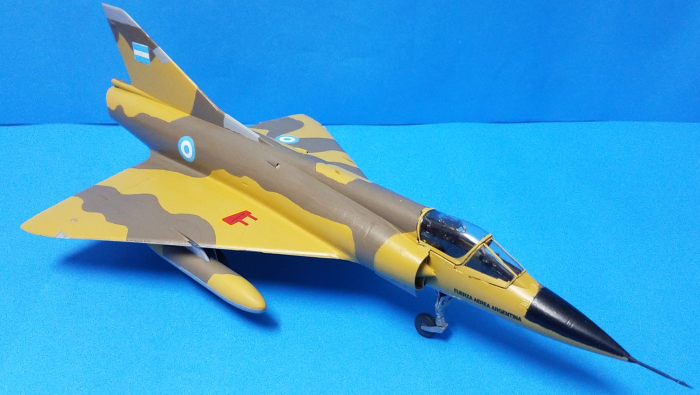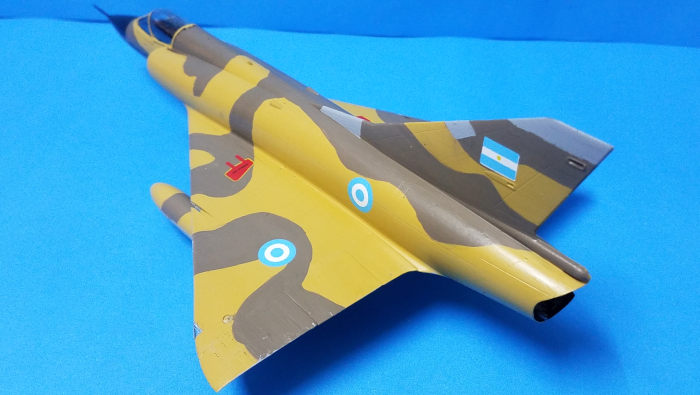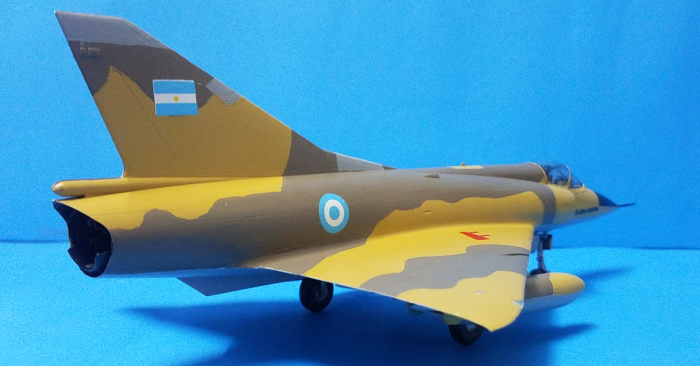
Hobby Boss 1/48 Mirage IIICJ
| KIT #: | 80316 |
| PRICE: | $54.00 |
| DECALS: | Two options |
| REVIEWER: | Francisco Santoro |
| NOTES: | Condor Decals 48054 "Mirage IIIEA/CJ in the Argentine Air Force" |

| HISTORY |
The Mirage IIIC version originated due to a contract between the French Air Force and Avions Marcel Dassault for 100 Mirage IIIA, which was confirmed on August 5 1958. Due to the constant testing by the manufacturer before beginning production, several modifications were added to the basic A model: An enlarged fuselage (14,73m) and a Thomson CSF Cyrano I bis radar optimised for interception. The first flight of the C version was on October 9 1960, at the Bordaux-Merignac airfield. At the controls was Jean Coreau.
 The
SCNECMA Atar 9B-3 engine provided 3880kg of thrust, and it gave 6000kg with
post combustion.
The
SCNECMA Atar 9B-3 engine provided 3880kg of thrust, and it gave 6000kg with
post combustion.
Initially, three underwing hard points could be installed, two under the wings and one under the fuselage. Each were capable of carrying 500 of bombs. In standard configuration, a missile R-511 was attached on the central hard point, and two supersonic fuel tanks of 500 litres or the RP62 tanks of 1200 litres were installed under the wings. For short range missions, the fuel tanks were replaced by two AIM-9B Sidewinders. Later, Matra developed the R-530 missile of infrared guidance witha range of 18km, replacing the R-511. To further increase the combat capacity of the Mirage, the other models received two more underwing hard points with capacity for Sidewinder missiles, Matra R-550 Magic and other armament.
Production for France ended in 1962 with the 92nd. Originally, they were delivered to the 2nd and 13th Fighter Squadrons in Dijon and Colmar respectively. The last operative flight of a French Mirage IIIC was in Djibouti on August 12 1988.
Together with the French machines, 89 more aircraft were manufactured, of which 72 were exported to Israel (denominated CJ and BJ) between July 1961 and July 1964, 16 to South Africa, and the remaining aircraft were delivered to Switzerland (Mirage IIICS).
| THE KIT |
Hobby Boss's Mirage IIICJ comes in a top opening box with six sprues inside: Three for the main parts, two for the weaponry and fuel tanks, and one clear sprue. The parts are molded in a light grey, hard plastic. The decal sheet has options for three Israeli Mirage IIICJs.
| CONSTRUCTION |
I began by checking the internet for the cockpit colour of the Mirage
IIICJ, since Hobby Boss doesn't provide colour callouts for it. Two photos
showed two different colours, Interior Green and Black. I went for Black, since
it would be easier to paint. The first thing I did was to paint the ejector seat
and cockpit in black, while that was drying I painted the wheel wells in
 aluminium.
After all the paint was dry, I assembled the ejector seat, cockpit and wheel
wells.
aluminium.
After all the paint was dry, I assembled the ejector seat, cockpit and wheel
wells.
With that done, I moved on to the wings. Before glueing the wings, you need to install the wheel wells and open up the holes for the fuel tanks of missiles. These were painted in aluminium, and when dry, were installed into the wings. I also opened the holes on the wings to make way for the 1200 litre fuel tanks.
After completing the wings, I decided the build the engine. This is a 7 parts assemble, which builds up quite fast and has to be glued to the right hand fuselage. I did so, and then moved on to attach the cockpit.
Now, onto the cockpit installation. Hobby Boss provides no indication of where to install the cockpit. but an indentation for the rear cockpit bulkhead indicates where to install it. Before closing the fuselage, I glued to the roof of the wheel wells a 30g lead weight, just to be sure the aircraft wasn't a tail sitter. After all that was dry, I glued the second half of the fuselage. I had to glue the two engine air intakes to the fuselage.
With the intakes glued, I glued the wings to the fuselage. This assembly resulted in some gaps, so I taped the fuselage and wings together so I could excert so pressure and close the gaps. With that done, I glued the ailerons in place. I also glued at this stage the ventral fin and the aileron actuators.
| COLORS & MARKINGS |
 I
wanted to have an Argentinian MIrage for quite some time. I chose, from the
Condor Decals decal sheet, Mirage IIICJ C-708 of the IV Air Brigade, based at El
Plumerillo, Mendoza, in 1985. The colour scheme was of Sand and Dark Earth. I
first painted the entire aircraft with Revell 16 Sand, and then free handed with
a medium brush Revell 87 Earth Brown. I then gloss coated the aircraft with two
coats of Revell gloss varnish to prepare the surface for the decals. I first put
the roundels, then the flag, the airbrakes "Do Not Step" on the wings, and then
the "Fuerza Aérea Argentina" indicators (one folded on itself and I couldn´t
recover it, luckily there were four of them provided. After decalling had been
completed, I matt coated the surface with Revell's matt varnish.
I
wanted to have an Argentinian MIrage for quite some time. I chose, from the
Condor Decals decal sheet, Mirage IIICJ C-708 of the IV Air Brigade, based at El
Plumerillo, Mendoza, in 1985. The colour scheme was of Sand and Dark Earth. I
first painted the entire aircraft with Revell 16 Sand, and then free handed with
a medium brush Revell 87 Earth Brown. I then gloss coated the aircraft with two
coats of Revell gloss varnish to prepare the surface for the decals. I first put
the roundels, then the flag, the airbrakes "Do Not Step" on the wings, and then
the "Fuerza Aérea Argentina" indicators (one folded on itself and I couldn´t
recover it, luckily there were four of them provided. After decalling had been
completed, I matt coated the surface with Revell's matt varnish.
I glued the landing gear in place, then the wheels and after that the landing gear doors. The landing gear installation is a bit weak, but it strengthens itself after the glue hardens. The fuel tanks were painted in the camouflage colour and were glued in place.
| CONCLUSIONS |
Hobby Boss's Mirage III is a good kit, it builds easily and has almost no issues. Recommended for all Mirage III fans out there.
Francisco Santoro
17 November 2020 Copyright ModelingMadness.com If you would like your product reviewed fairly and fairly quickly, please contact the editor or see other details in the
Note to
Contributors. Back to the Main Page
Back to the Review
Index Page
Back to the Previews Index Page